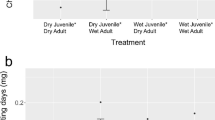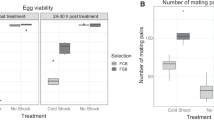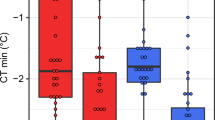Abstract
Avoiding water loss for insects is critical for survival. Selection for reduced water loss will depend on trade-offs between resources allocated for reproduction and those allocated for resisting desiccation. However, we lack knowledge on how selection for desiccation resistance can affect the male ejaculate. Furthermore, as male ejaculate composition is complex, desiccation resistant females could evolve traits that enable them to derive longevity benefits from mating. Here, we assessed how selection for desiccation resistance impacts male testes and accessory gland size, protein content of these organs, female sperm storage and male ability to inhibit female remating behavior, in the Mexican fruit fly Anastrepha ludens. Additionally, we tested if mating increased longevity and fecundity in desiccation resistant females. Males selected for resistance to desiccation stress had smaller accessory glands and seminal vesicles and females mating with these males stored less sperm compared to control males. Females mating with resistant males had lower fecundity compared to females mating with control males. Desiccation resistant females lived longer than control females, yet this was irrespective of mating. Rapid evolutionary responses to hydric stress can have correlated effects in reproductive capabilities, which are not restricted to pre-copulatory traits. Trade-offs between resistance to desiccation stress are reflected in decreased allocation of resources to reproductive organs. Thus, production of the ejaculate may be costly for A. ludens males. Knowledge on the evolution of ejaculate traits and reproductive organ size in response to directional selection for desiccation resistance, will aid our understanding of differential sex-specific responses to environmental stress.





Similar content being viewed by others
References
Abraham, S., Lara-Pérez, L. A., Rodríguez, C., Contreras-Navarro, Y., Nuñez-Beverido, N., Ovruski, S. & Pérez-Staples, D. (2016). The male ejaculate as inhibitor of female remating in two tephritid flies. Journal of Insect Physiology, 88, 40–47.
Abraham, S., Nuñez-Beverido, N., Contreras-Navarro, Y., & Pérez-Staples, D. (2014). Female receptivity in Anastrepha ludens (Diptera: Tephritidae) is not modulated by male accessory gland products. Journal of Insect Physiology, 70, 41–48.
Avila, F. W., Sirot, L. K., LaFlamme, B. A., Rubinstein, C. D., & Wolfner, M. F. (2011). Insect seminal fluid proteins: Identification and function. Annual Review of Entomology, 56, 21–40.
Bradford, M. (1976). A rapid and sensitive method for the quantification of microgram quantities of protein utilizing the principle of protein-dye binding. Analytical Biochemistry, 72, 248–254.
Brunel, O., & Rull, J. (2010). The natural history and unusual mating behavior of Euxesta bilimeki (Diptera: Ulidiidae). Annals of the Entomological Society of America, 103(1), 111–119.
Burke, M. K., & Rose, M. R. (2009). Experimental evolution with Drosophila. American Journal of Physiology—Regulatory, Integrative and Comparative Physiology, 296(6), R1847-R1854.
Celedonio-Hurtado, H., Aluja, M., & Liedo, P. (1995). Adult population fluctuations of Anastrepha species (Diptera: Tephritidae) in tropical orchard habitats of Chiapas, Mexico. Environmental Entomology, 24(4), 861–869.
Chapman, T., Herndon, L. A., Heifetz, Y., Partridge, L., & Wolfner, M. F. (2001). The Acp26Aa seminal fluid protein is a modulator of early egg hatchability in Drosophila melanogaster. Proceedings of the Royal Society of London. Series B: Biological Sciences, 268(1477), 1647.
Chown, S. L., Sørensen, J. G., & Terblanche, J. S. (2011). Water loss in insects: An environmental change perspective. Journal of Insect Physiology, 57(8), 1070–1084.
Cloudsley-Thompson, J. L. (1975). Adaptations of arthropoda to arid environments. Annual Review of Entomology, 20(1), 261–283.
Dewsbury, D. A. (1982). Ejaculate cost and male choice. American Naturalist, 119, 601–610.
Edvardsson, M., & Canal, D. (2006). The effects of copulation duration in the bruchid beetle Callosobruchus maculatus. Behavioral Ecology, 17(3), 430–434.
Flatt, T. (2011). Survival costs of reproduction in Drosophila. Experimental Gerontology, 46(5), 369–375.
Gefen, E., & Brendzel, O. (2011). Desiccation resistance and mating behaviour in laboratory populations of Drosophila simulans originating from the opposing slopes of Lower Nahal Oren (Israel). Journal of Evolutionary Biology, 24(10), 2110–2117.
Gefen, E., & Gibbs, A. G. (2009). Interactions between environmental stress and male mating success may enhance evolutionary divergence of stress-resistant Drosophila populations. Evolution, 63(6), 1653–1659.
Gillott, C. (2003). Male accessory gland secretions: Modulators of female reproductive physiology and behavior. Annual Review of Entomology, 48, 163–184.
Goenaga, J., Mensch, J., Fanara, J. J., & Hasson, E. (2012). The effect of mating on starvation resistance in natural populations of Drosophila melanogaster. Evolutionary Ecology, 26(4), 813–823.
Haerty, W., Jagadeeshan, S., Kulathinal, R. J., Wong, A., Ravi Ram, K., Sirot, L. K., Levesque, L., Artieri, C. G., Wolfner, M. F., Civetta, A., et al. (2007). Evolution in the fast lane: Rapidly evolving sex-related genes in Drosophila. Genetics, 177(3), 1321–1335.
Harano, T. (2012). Water availability affects female remating in the seed beetle, Callosobruchus chinensis. Ethology, 118(10), 925–931.
Harwood, J. F., Chen, K., Liedo, P., Muller, H. G., Wang, J. L., Morice, A. E., & Carey, J. R. (2015). Female access and diet affect insemination success, senescence, and the cost of reproduction in male Mexican fruit flies Anastrepha ludens. Physiological Entomology, 40(1), 65–71.
Heifetz, Y., Tram, U., & Wolfner, M. F. (2001) Male contributions to egg production: The role of accessory gland products and sperm in Drosophila melanogaster. Proceedings of the Royal Society of London. Series B: Biological Sciences, 268(1463),175.
Hoffmann, A. A., & Harshman, L. G. (1999) Desiccation and starvation resistance in Drosophila: Patterns of variation at the species, population and intrapopulation levels. Heredity (Edinb), 83(Pt 6), 637–643.
Huestis, D. L., & Lehmann, T. (2014). Ecophysiology of Anopheles gambiae s.l.: Persistence in the Sahel. Infection, Genetics and Evolution, 28, 648–661.
Karla, B., & Parkash, R. (2014). Trade-off of ovarian lipids and total body lipids for fecundity and starvation resistance in tropical populations of Drosophila melanogaster. Journal of Evolutionary Biology, 27(11), 2371–2385.
Knowles, L. L., Brodie Hernández, B., & Markow, T. A. (2005). Nonantagonistic interactions between the sexes revealed by the ecological consequences of reproductive traits. Journal of Evolutionary Biology, 18, 156–161.
Knowles, L. L., Hernandez, B. B., & Markow, T. A. (2004). Exploring the consequences of postmating-prezygotic interactions between the sexes. Proceedings of the Royal Society of London. Series B: Biological Sciences, 271(Suppl 5), S357–S359.
Kwan, L., Bedhomme, S., Prasad, N. G., & Chippindale, A. K. (2008). Sexual conflict and environmental change: Trade-offs within and between the sexes during the evolution of desiccation resistance. Journal of Genetics, 87(4), 383–394.
Kwan, L., & Rundle, H. D. (2010). Adaptation to desiccation fails to generate pre- and postmating isolation in replicate Drosophila melanogaster laboratory population. Evolution, 64(3), 710–723.
Liao, H. J., Qian, Q., & Liu, X. D. (2014). Heat shock suppresses mating and sperm transfer in the rice leaf folder Cnaphalocrocis medinalis. Bulletin of Entomological Research, 104(3), 383–392.
Martínez, I., & Hernández-Ortiz, V. (1997) Anatomy of the reproductive system in six Anastrepha species and comments regarding their terminology in Tephritidae (Diptera). Proceedings of the Entomological Society of Washington, 99, 727–743.
Matzkin, L. M., Watts, T. D., & Markow, T. A. (2009). Evolution of stress resistance in Drosophila: Interspecific variation in tolerance to desiccation and starvation. Functional Ecology, 23(3), 521–527.
Meza, J. S., Arredondo, J., Orozco, D., & Pérez-Staples, D. (2014). Disparity in sexual behaviour between wild and mass-reared Mexican fruit flies. Physiological Entomology, 39(3), 263–270.
Olsson, M., Madsen, T., & Shine, R. (1997) Is sperm really so cheap? Costs of reproduction in male adders, Vipera berus. Proceedings of the Royal Society of London. Series B: Biological Sciences, 264, 455–459.
Perry, J. C., Sirot, L., & Wigby, S. (2013). The seminal symphony: How to compose an ejaculate. Trends in Ecology & Evolution, 28(7), 414–422.
Pitnick, S., Markow, T., & Spicer, G. S. (1999). Evolution of multiple kinds of female sperm-storage organs in Drosophila. Evolution, 53(6), 1804–1822.
Pitnick, S., Spicer, G. S., & Markow, T. (1997). Phylogenetic examination of female incorporation of ejaculate in Drosophila. Evolution, 51(3), 833–845.
Price, P. W. (1997). Insect ecology (3rd edn.). New York: Wiley.
R Core Team (2016). R: A language and environment for statistical computing. Vienna: R Foundation for Statistical Computing. http://www.R-project.org/.
Reinhardt, K., Dobler, R., & Abbott, J. (2016). An ecology of sperm: Sperm diversification by natural selection. Annual Review of Ecology, Evolution and Systematics, 46, 435–459.
Reyes-Hernández, M., & Pérez-Staples, D. (2017). Mating senescence and male reproductive organ size in the Mexican fruit fly. Physiological Entomology, 42(1), 26–35.
Rion, S., & Kawecki, T. J. (2007). Evolutionary biology of starvation resistance: What we have learned from Drosophila. Journal of Evolutionary Biology, 20(5), 1655–1664.
Rodriguez-Enriquez, C., Tadeo, E., & Rull, J. (2013). Elucidating the function of ejaculate expulsion and consumption after copulation by female Euxesta bilimeki. Behavioral Ecology and Sociobiology, 67(6), 937–946.
Rohmer, C., David, J. R., Moreteau, B., & Joly, D. (2004). Heat induced male sterility in Drosophila melanogaster: Adaptive genetic variations among geographic populations and role of the Y chromosome. Journal of Experimental Biology, 207, 2735–2743.
Rose, M. R. (1984). Laboratory evolution of postponed senescence in Drosophila melanogaster. Evolution, 38, 1004–1010.
Ruiz-Arce, R., Owen, C. L., Thomas, D. B., Barr, N. B., & McPheron, B. A. (2015). Phylogeographic structure in Anastrepha ludens (Diptera: Tephritidae) populations inferred with mtDNA sequencing. Journal of Economic Entomology, 108(3), 1324–1336.
Rush, B., Sandver, S., Bruer, J., Roche, R., Wells, M., & Giebultowicz, J. (2007). Mating increases starvation resistance and decreases oxidative stress resistance in Drosophila melanogaster females. Aging Cell, 6(5), 723–726.
SAS, Institute Inc. (2010). JMP ver. 7, ver. 9. SAS, Institute Inc: Carey, NC.
Sassi, P. L., & Hasson, E. (2013). Desiccation resistance along an aridity gradient in the cactophilic fly Drosophila buzzatii: Sex-specific responses to stress. Evolutionary Ecology, 27(3), 505–519.
Service, P. M., Hutchinson, E. W., MacKinley, M. D., & Rose, M. R. (1985). Resistance to environmental stress in Drosophila melanogaster selected for postponed senescence. Physiological Zoology, 58(4), 380–389.
Singh, K., Samant, M. A., Tom, M. T., & Prasad, N. G. (2016) Evolution of pre- and post-copulatory traits in male Drosophila melanogaster as a correlated response to selection for resistance to cold stress. PLoS ONE, 11(4), e0153629.
Sirot, L. K., Wolfner, M. F., & Wigby, S. (2011). Protein-specific manipulation of ejaculate composition in response to female mating status in Drosophila melanogaster. Proccedings of the National Academy of Science USA, 108(25), 9922–9926.
Stinziano, J. R., Sové, R. J., Rundle, H. D., & Sinclair, B. J. (2015). Rapid desiccation hardening changes the cuticular hydrocarbon profile of Drosophila melanogaster. Comparative Biochemistry and Physiology Part A: Molecular & Integrative Physiology, 180, 38–42.
Stone, A. (1942). The fruit flies of the genus Anastrepha (Miscellaneous Publication No. 439) (p. 112). Washington, DC: USDA.
Taylor, P. W., Kaspi, R., & Yuval, B. (2000). Copula duration and sperm storage in Mediterranean fruit flies from a wild population. Physiological Entomology, 25, 94–99.
Tejeda, M. T., Arredondo, J., Liedo, P., Pérez-Staples, D., Ramos-Morales, P., & Díaz-Fleischer, F. (2016). Reasons for success: Rapid evolution for desiccation resistance and life-history changes in the polyphagous fly Anastrepha ludens. Evolution, 70(11), 2583–2594.
Tejeda, M. T., Arredondo, J., Pérez-Staples, D., Ramos-Morales, P., Liedo, P., & Díaz-Fleischer, F. (2014). Effects of size, sex and teneral resources on the resistance to hydric stress in the tephritid fruit fly Anastrepha ludens. Journal of Insect Physiology, 70, 73–80.
Thomas, D. B. (2003). Reproductive phenology of the Mexican fruit fly, Anastrepha ludens (Loew) (Diptera: Tephritidae) in the Sierra Madre Oriental, Northern Mexico. Neotropical Entomology, 32, 385–397.
Ursprung, C., den Hollander, M., & Darryl, T. G. (2009). Female seed beetles, Callosobruchus maculatus, remate for male-supplied water rather than ejaculate nutrition. Behavioral Ecology and Sociobiology, 63(6), 781–788.
Wedell, N., Gage, M. J. G., & Parker, G. A. (2002). Sperm competition, male prudence and sperm-limited females. Trends in Ecology and Evolution, 17, 313–320.
Weldon, C. W., Boardman, L., Marlin, D., & Terblanche, J. S. (2016). Physiological mechanisms of dehydration tolerance contribute to the invasion potential of Ceratitis capitata (Wiedemann) (Diptera: Tephritidae) relative to its less widely distributed congeners. Frontiers in Zoology, 13(1), 1–15.
Weldon, C. W., Yap, S., & Taylor, P. W. (2013). Desiccation resistance of wild and mass-reared Bactrocera tryoni (Diptera: Tephritidae). Bulletin of Entomological Research, 103(6), 690–699.
Wigby, S., Perry, J. C., Kim, Y.-H., & Sirot, L. K. (2016). Developmental environment mediates male seminal protein investment in Drosophila melanogaster. Functional Ecology, 30(3), 410–419.
Xu, J., & Wang, Q. (2011). Seminal fluid reduces female longevity and stimulates egg production and sperm trigger oviposition in a moth. Journal of Insect Physiology, 57(3), 385–390.
Zera, A. J., & Harshman, L. G. (2001). The physiology of life history trade-offs in animals. Annual Review of Ecology and Systematics, 32(1), 95–126.
Acknowledgements
We thank Nicolás Núñez-Beverido, Yair de Jesús Contreras, Evaristo Calihua, Carlos Carmona, Cruz Perea Castellanos, Javier Coutiño Ibarias and Desarrollo de Métodos, Programa Moscafrut (SAGARPA-SENASICA) for help throughout experiments. Enrique Alarcón and Antonio Andrade (INBIOTECA) provided access to equipment. We thank Dinesh Rao for comments to the manuscript. DPS thanks Kavita Isvaran for hosting her at the Indian Institute of Science, Bangalore, India during her sabbatical. SA was supported by a postdoctoral grant from CONICET, Argentina, MHC by a CONACyT postdoctoral scholarship, and MRH by a CONACyT doctoral scholarship. Funding was provided by the Consejo Nacional de Ciencia y Tecnología (CONACyT) Ciencia Básica Grant Number CB-2011-169887 awarded to FDF.
Author information
Authors and Affiliations
Corresponding author
Ethics declarations
Conflict of interest
The authors declare that they have no conflict of interest.
Rights and permissions
About this article
Cite this article
Pérez-Staples, D., Abraham, S., Herrera-Cruz, M. et al. Evolutionary Consequences of Desiccation Resistance in the Male Ejaculate. Evol Biol 45, 56–66 (2018). https://doi.org/10.1007/s11692-017-9429-4
Received:
Accepted:
Published:
Issue Date:
DOI: https://doi.org/10.1007/s11692-017-9429-4




